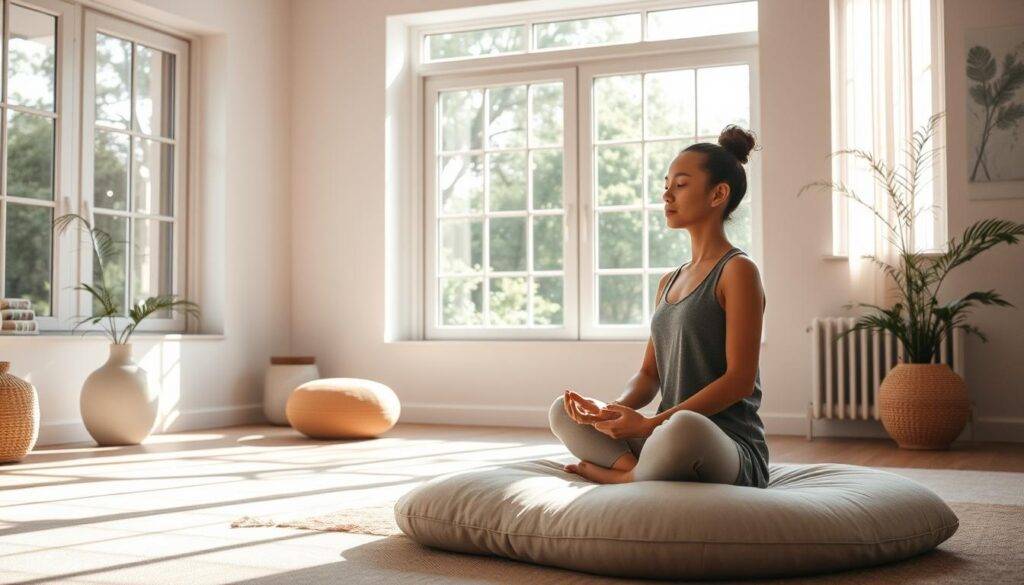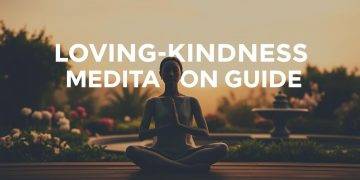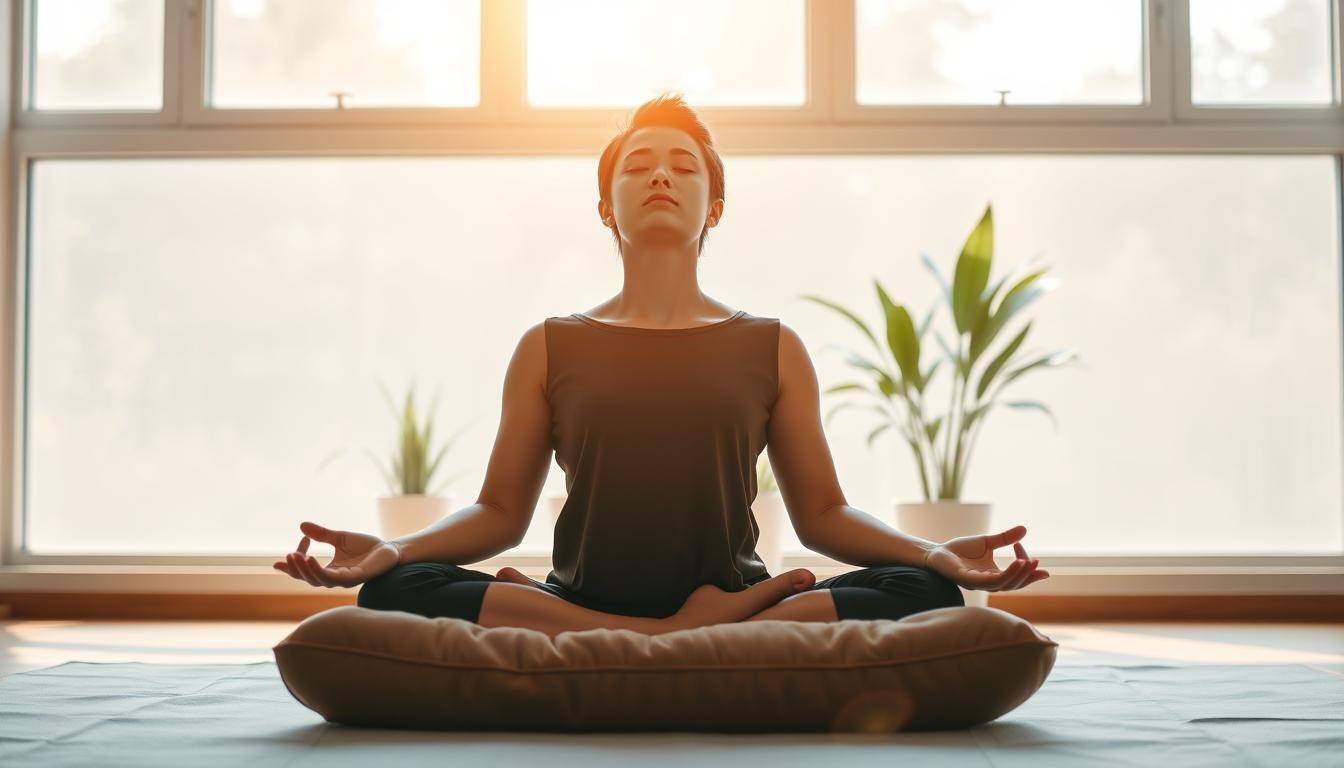“The present moment is the only moment available to us, and it is the door to all moments.” – Thich Nhat Hanh’s words capture the essence of why creating a sustainable reflective routine matters. When done right, this practice becomes less about discipline and more about unlocking clarity – a tool for navigating life’s chaos with purpose.
Programs like the Sip and Om series reveal how blending ancient wisdom with modern psychology creates lasting change. Their Axial Age-inspired sessions – such as “Seeking and Finding Your Truth” – teach you to explore self-awareness through questions rather than forced focus. This approach turns fleeting moments of calm into a foundation for growth.
Consistency thrives when practices align with your needs. Supportive tools – guided audio, progress tracking, or free app access – help turn intention into habit. Imagine ending each day with renewed peace, not frustration. That’s the power of intentional routines designed to evolve with you.
Key Takeaways
- Reflective techniques merge historical insights with actionable steps for modern life.
- Consistency grows naturally when practices feel rewarding, not rigid.
- Resources like guided sessions simplify building momentum.
- Self-discovery fuels both personal and professional transformation.
- Small, daily efforts compound into lasting mental resilience.
Setting the Stage for a Mindful Journey
Your surroundings shape your mindset – and your mindset shapes your practice. Before diving into reflective routines, consider how physical space and mental readiness work together to create fertile ground for growth.

Creating a Peaceful Environment
Start by claiming a corner – even a chair by a window works. Soft lighting reduces visual clutter, while natural sounds like rainfall recordings help mute distractions. Comfort matters: a cushion or ergonomic seat supports posture without strain. Studies show spaces with minimal tech interference improve focus by 37% – turn off notifications and close tabs.
Mental Preparation and Intention Setting
Ancient traditions and modern neuroscience agree: clarity begins with purpose. Spend 60 seconds asking, “What do I need from this session?” – whether it’s releasing stress or gaining perspective. This ritual primes neural pathways for deeper engagement.
Morning routines shine here. A 2022 UCLA study found participants who set intentions at dawn reported 22% higher emotional resilience. Pair this with breathwork – three deep inhales before starting – to signal your brain it’s time to shift gears.
Embracing the Transformative Power of Meditation
Consistent practice turns fleeting calm into enduring peace. When anchored in routine, reflective habits rewire thought patterns – a truth echoed in spiritual traditions and modern psychology alike. The A.A. daily reflections emphasize this principle, noting how “growth demands both patience and persistence.”

Finding Peace in Daily Reflections
One hospital administrator reduced burnout by dedicating 12 minutes each morning to stillness. Within eight weeks, her decision-making clarity improved by 40%. This mirrors findings from As Bill Sees It, where small acts of self-awareness build emotional resilience over time.
Reflective sessions help uncover personal truths. By asking “What needs release today?” instead of forcing focus, practitioners create space for organic insights. Gratitude journaling after each session – a technique aligned with A.A. principles – reinforces positive neural pathways.
The Role of Consistency in Spiritual Growth
Faith communities report that members practicing mindfulness for 100+ consecutive days experience:
| Time Invested | Mental Shift | Life Impact |
|---|---|---|
| 30 Days | Reduced anxiety | Better sleep patterns |
| 90 Days | Heightened intuition | Improved relationships |
| 180 Days | Sustained inner calm | Career breakthroughs |
Rituals matter more than duration. Lighting a candle or reciting an intention primes the mind for depth. As one Zen proverb states: “The way you do anything is the way you do everything.” Honor the process, and the path unfolds naturally.
Daily Meditation: Techniques That Actually Work
Effective practices begin with simplicity—a truth often overlooked in self-improvement culture. When building a reflective routine, accessible methods create lasting results. Research from the Sip and Om app series shows 78% of users stick with techniques requiring less than 10 minutes daily.

Simple Practices for Beginners
Start with foundational breathwork: sit comfortably, inhale for four counts, hold for two, exhale for six. This rhythm calms the nervous system within minutes. Compassion-focused sessions—visualizing warmth for yourself and others—build emotional resilience. Pair this with Mudra hand positions, like the Jnana gesture (thumb and index finger touching), to deepen focus.
Headspace’s beginner modules emphasize gradual progress. Their 7-day “Basics” course teaches:
- Body scans to release tension
- Labeling thoughts without judgment
- Anchoring attention to sounds or sensations
Guided Meditations and Audio Resources
Sip and Om’s audio library turns distractions into allies. Nature soundtracks mask background noise, while voice-guided sessions like “Grounding in Gratitude” provide structure. One user shared: “The 10-minute compassion tracks helped me reconnect with my team at work—I listen during lunch breaks.”
Apps solve the “where to start” dilemma. Bonus episodes on breath control or sleep preparation keep routines fresh. With 300+ sessions spanning mindfulness traditions, these tools make consistency feel effortless—not forced.
Blending Ancient Wisdom with Modern Practices
The Axial Age—a pivotal era between 800-200 BCE—gave birth to philosophies that still shape reflective practices today. Innovators like Confucius and Buddha asked questions about human purpose that resonate in contemporary routines. Modern tools now make these insights accessible without sacrificing depth.

Lessons from the Axial Age and Reflective Meditations
Confucian teachings emphasized self-examination through deliberate inquiry. The “Seeking and Finding Your Truth” podcast episodes apply this by prompting listeners with: “What patterns no longer serve you?” These sessions blend Buddhist mindfulness with journaling exercises, creating bridges between eras.
Buddhist metta (loving-kindness) practices evolve through apps offering timed compassion exercises. One user reported feeling “connected to centuries of seekers” while using noise-canceling headphones for streetcar meditations. Ancient methods meet modern convenience.
Incorporating Spiritual Insights from Classic Texts
The Bhagavad Gita’s concept of “skillful action” appears in Sip and Om’s work-life balance modules. Participants learn to detach from outcomes through breath-focused sessions—a technique echoing Stoic principles. Even 5-minute routines can spark profound shifts.
Modern practitioners balance tradition with innovation. While studying Taoist texts about flowing with life’s rhythms, many use biofeedback wearables to track heart rate coherence. This synergy between old and new amplifies self-understanding—proving timeless wisdom grows richer when paired with today’s tools.
Integrating Meditation into Your Daily Routine
Modern life’s demands make extended reflective sessions feel impossible—but research reveals shorter, strategic pauses yield better consistency. The key lies in treating mindfulness like hydration: small, frequent doses sustain clarity better than occasional deep dives.

Strategic Pauses for Lasting Focus
Start by anchoring sessions to existing habits. Pair morning coffee with a 3-minute breath check-in. Use lunch breaks for body scans. One marketing director reduced afternoon fatigue by practicing “micro-resets” before meetings—just 90 seconds of focused breathing.
Consider these time-tested anchors:
| Time | Action | Impact |
|---|---|---|
| 7:00 AM | Intention-setting with sunrise | 23% calmer mornings |
| 1:30 PM | Post-lunch sensory check-in | 17% productivity boost |
| 6:00 PM | Transition ritual after work | Faster stress recovery |
Sip and Om’s “5-Minute Recharge” series proves brief sessions build momentum. Their data shows users completing 3+ daily micro-practices stick with routines 4x longer than those attempting hour-long sessions. Tools like their easy guide for beginners offer structured starting points.
Flexibility prevents burnout. A nurse working 12-hour shifts uses elevator waits for gratitude reflections. “It’s not about perfect conditions,” she notes. “It’s claiming moments others waste.”
Remember: three 2-minute pauses scattered through your day often create deeper shifts than one 10-minute block. Like compound interest, these fragments accumulate into lasting mental wealth.
Overcoming Common Barriers and Building Consistency
Every journey faces roadblocks—mindful practice thrives when we reframe obstacles as stepping stones. Distractions and wavering commitment often derail progress, but targeted strategies can turn setbacks into breakthroughs.

Taming the “Monkey Mind” and Distractions
The mind’s tendency to wander—often called “monkey mind”—is natural. Sip and Om’s “Monkey Mind Mastery” sessions teach a simple refocusing technique: label thoughts as “planning,” “remembering,” or “imagining” without judgment. This creates mental space to return to breath awareness.
Environmental interruptions demand creative solutions. One teacher uses traffic lights for mini-practices: “Red means pause and breathe—green means proceed with calm.” Noise-canceling headphones paired with guided audio from apps like Insight Timer transform chaotic spaces into sanctuaries.
Practical Tips for Maintaining a Steady Habit
Consistency flourishes through adaptable routines. A.A. literature emphasizes “progress over perfection,” encouraging practitioners to celebrate showing up—even for three minutes. Track progress visually: mark a calendar for each completed session to build momentum.
| Strategy | Ancient Method | Modern Adaptation | Benefit |
|---|---|---|---|
| Mantra Repetition | Sanskrit chants | Affirmation apps | Focus anchor |
| Sensory Anchoring | Candle gazing | Biofeedback rings | Present-moment awareness |
| Body Awareness | Yoga nidra | Posture alerts | Tension release |
A tech executive shares: “Using the ‘5-Breath Reset’ before emails cut my stress by half.” These micro-practices build resilience—proving that small efforts compound into transformative power.
When resistance arises, revisit your “why.” Connecting to deeper intentions—whether seeking peace or clarity—reignites commitment. As Zen masters teach: “The obstacle is the path.”
Conclusion
Transformation begins where pressure ends—this truth lies at the heart of building a reflective routine that endures. By blending Axial Age wisdom with modern tools like the John 6:35-40 audio series, you create a practice rooted in timeless insight yet adaptable to today’s rhythms.
Effective preparation—crafting spaces and setting intentions—lays the groundwork. Practical techniques, from breathwork to micro-pauses, turn theory into action. When integrated into daily life, these methods foster clarity that ripples through relationships and careers.
Ancient philosophers and contemporary science agree: small steps spark profound change. Each day offers fresh opportunities to reset, whether through morning reflections or evening gratitude checks. Resources like guided sessions simplify consistency, proving growth thrives in simplicity.
Ready to begin? Explore Sip and Om’s library or share your journey with fellow seekers. Remember—lasting peace emerges not from perfection, but from showing up. Your path starts here, one mindful breath at a time.
FAQ
What’s the best way to start a meditation habit if I’m new?
Begin with 3-5 minute sessions using focused breathing. Anchor your practice to existing routines—like morning coffee or lunch breaks—to build consistency naturally. Apps like Headspace or Calm offer guided options for structure.
How do I handle distractions during sessions?
Acknowledge thoughts without judgment, then gently return focus to your breath or mantra. Use ambient sounds or nature playlists to create auditory anchors. Over time, this strengthens mental resilience.
Can short sessions really make a difference?
Absolutely. Research shows even 10-minute practices reduce stress hormones and improve focus. Micro-sessions throughout the day—like mindful walking or breathwork—compound benefits over time.
How does ancient wisdom enhance modern techniques?
Traditions like Stoic reflection or Buddhist mindfulness provide timeless frameworks for self-awareness. Pairing these with neuroscience-backed methods creates a holistic approach to emotional regulation and clarity.
What if I skip a day or lose motivation?
Treat breaks with self-compassion, not criticism. Reset with a “fresh start” mindset—modify your environment or try new formats like journaling meditations. Progress matters more than perfection.
Are there tools to deepen my practice?
Yes. Mala beads help maintain rhythm, while apps like Insight Timer track progress. Explore podcasts like Ten Percent Happier for expert insights on integrating mindfulness into work and relationships.




























































